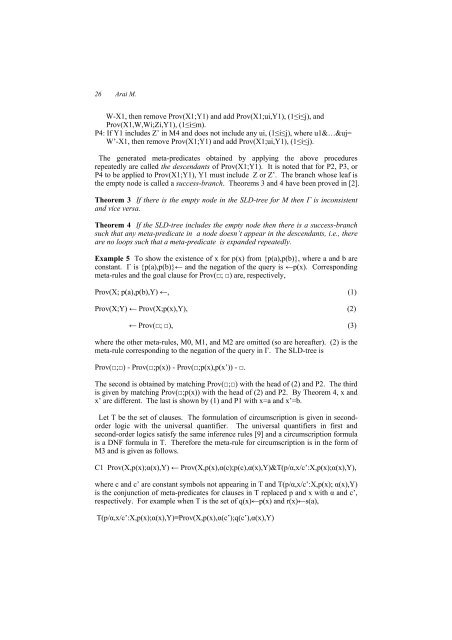Advances in Artificial Intelligence Theory - MICAI - Mexican ...
Advances in Artificial Intelligence Theory - MICAI - Mexican ...
Advances in Artificial Intelligence Theory - MICAI - Mexican ...
You also want an ePaper? Increase the reach of your titles
YUMPU automatically turns print PDFs into web optimized ePapers that Google loves.
W-X1, then remove Prov(X1;Y1) and add Prov(X1;ui,Y1), (1≤i≤j), and<br />
Prov(X1,W,Wi;Zi,Y1), (1≤i≤m).<br />
P4: If Y1 <strong>in</strong>cludes Z’ <strong>in</strong> M4 and does not <strong>in</strong>clude any ui, (1≤i≤j), where u1&…&uj=<br />
W’-X1, then remove Prov(X1;Y1) and add Prov(X1;ui,Y1), (1≤i≤j).<br />
The generated meta-predicates obta<strong>in</strong>ed by apply<strong>in</strong>g the above procedures<br />
repeatedly are called the descendants of Prov(X1;Y1). It is noted that for P2, P3, or<br />
P4 to be applied to Prov(X1;Y1), Y1 must <strong>in</strong>clude Z or Z’. The branch whose leaf is<br />
the empty node is called a success-branch. Theorems 3 and 4 have been proved <strong>in</strong> [2].<br />
Theorem 3 If there is the empty node <strong>in</strong> the SLD-tree for M then Γ is <strong>in</strong>consistent<br />
and vice versa.<br />
Theorem 4 If the SLD-tree <strong>in</strong>cludes the empty node then there is a success-branch<br />
such that any meta-predicate <strong>in</strong> a node doesn’t appear <strong>in</strong> the descendants, i.e., there<br />
are no loops such that a meta-predicate is expanded repeatedly.<br />
Example 5 To show the existence of x for p(x) from {p(a),p(b)}, where a and b are<br />
constant. Γ is {p(a),p(b)}← and the negation of the query is ←p(x). Correspond<strong>in</strong>g<br />
meta-rules and the goal clause for Prov(□; □) are, respectively,<br />
Prov(X; p(a),p(b),Y) ←, (1)<br />
Prov(X;Y) ← Prov(X;p(x),Y), (2)<br />
← Prov(□; □), (3)<br />
where the other meta-rules, M0, M1, and M2 are omitted (so are hereafter). (2) is the<br />
meta-rule correspond<strong>in</strong>g to the negation of the query <strong>in</strong> Γ. The SLD-tree is<br />
Prov(□;□) - Prov(□;p(x)) - Prov(□;p(x),p(x’)) - □.<br />
The second is obta<strong>in</strong>ed by match<strong>in</strong>g Prov(□;□) with the head of (2) and P2. The third<br />
is given by match<strong>in</strong>g Prov(□;p(x)) with the head of (2) and P2. By Theorem 4, x and<br />
x’ are different. The last is shown by (1) and P1 with x=a and x’=b.<br />
Let T be the set of clauses. The formulation of circumscription is given <strong>in</strong> secondorder<br />
logic with the universal quantifier. The universal quantifiers <strong>in</strong> first and<br />
second-order logics satisfy the same <strong>in</strong>ference rules [9] and a circumscription formula<br />
is a DNF formula <strong>in</strong> T. Therefore the meta-rule for circumscription is <strong>in</strong> the form of<br />
M3 and is given as follows.<br />
C1 Prov(X,p(x);α(x),Y) ← Prov(X,p(x),α(c);p(c),α(x),Y)&T(p/α,x/c’:X,p(x);α(x),Y),<br />
where c and c’ are constant symbols not appear<strong>in</strong>g <strong>in</strong> T and T(p/α,x/c’:X,p(x); α(x),Y)<br />
is the conjunction of meta-predicates for clauses <strong>in</strong> T replaced p and x with α and c’,<br />
respectively. For example when T is the set of q(x)←p(x) and r(x)←s(a),<br />
T(p/α,x/c’:X,p(x);α(x),Y)≡Prov(X,p(x),α(c’);q(c’),α(x),Y)

















